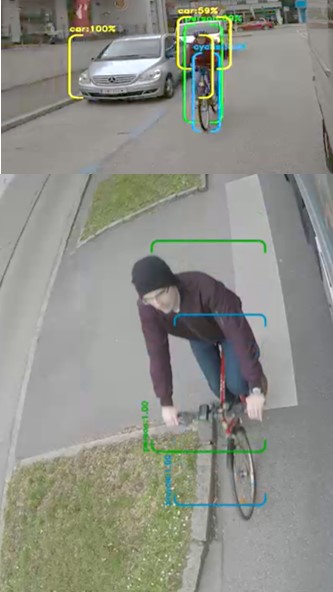RAILEYE® 4.0
RAILEYE®4.0 - The digital rear view mirror system from EYYES
represents a highly secure digital rearview mirror system for public transport vehicles. It consists of several high-resolution cameras on the outside of the vehicle, HD monitors in the driver’s area and the intelligent video links for controlling and monitoring the components used with the artificial intelligence integrated on EYYES.net. Raileye® 4.0 is a digital system and meets SIL1 functional safety requirements and other safety-related requirements (ASIL). The Raileye® system is a self-monitoring system. It takes over an essential part of the driver’s responsibility – a check on the correct functioning of the system. Thanks to artificial intelligence, the system recognizes and detects people and other road users in danger zones and warns the driving personnel immediately and reliably. This technology, which is already being used successfully in the automotive sector, is the basis not only for the digital rear-view mirror system but also for assistance systems such as blind-spot monitoring, front collision or the option of partially automated dispatch. The highly secure system according to SIL 1 does not require any additional hardware to determine the authenticity of the video images. The display of images on the monitors is virtually instantaneous, with an offset of less than 100 milliseconds. The system architecture prevents freezing of images. To reduce the number of monitors, the system supports multiple display of cameras on only one monitor, also according to SIL 1.

Functions and features of Raileye® 4.0
- Highly safe digital system according to SIL1
- Recognizes and detects people and other road users in danger zones and blind spots
- The AI calculates the expected direction of movement (trajectory) of the detected objects
- Does not require additional hardware to determine the authenticity of video images
- Provides virtually delay-free digital display of images (less than 100 ms)
- Allows multiple display of cameras on only one monitor, also according to SIL1
thanks to AI.
- One-Wire single-cable power supply for cameras and monitors reduces installation and cabling effort
- Railway-ready cameras ensure excellent digital image quality in all weather conditions
- Integrated Power Heating de-ices cameras in under 150 seconds at -25°
- High temperature and vibration resistance of rear-view mirror monitors ensure brilliant images every time, thanks to high contrast ratio and automatic brightness control
-
CAMERA
High resolution digital camera sensor technology with integrated heater to detect all detailed information
-
SCREEN
The HD monitor gives the driver a complete representation of the environment
-
RIC-BOX
The central control unit with integrated AI and functional safety according to SIL1
-
SIGNALER
Visual and audible driver information to indicate indications and hazards by means of signaling devices
Detection in the streetcar
Detection in the streetcar
Advantages through AI
- can be used for new vehicles or as a retrofit solution
- Fully digital system – can be used flexibly, high-resolution sensor systems
- AI detection modules based on deep neural networks – RailEye understands complex situations, generates predictions, detects collision hazards
- Reliable warning by including non-relevant objects – thus reducing false alarms
- Situation-based and automated display of image sections (eg full screen, split image, quad image)

Turning assistant with AI
- Objects are detected and classified. This allows to distinguish between cars, trucks, people, bicycles, … and static objects (tree, bollard,…).
- Expected direction of movement of the detected objects is calculated (trajectory). If an object is in the danger zone but moves away from it, only a hint (yellow light signal) is given to the driver.
- The driver receives a warning (red light and acoustic signal) only if there is a risk of collision (minimized error rate)
- To do this, among other things, the direction of movement of its own vehicle as well as the calculated probable direction of movement of the object is used. If both vectors overlap, a warning is issued.
